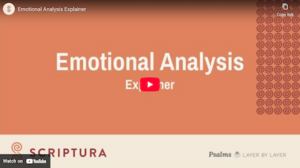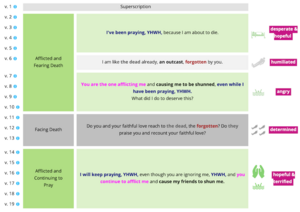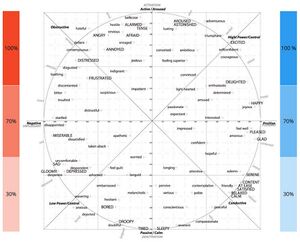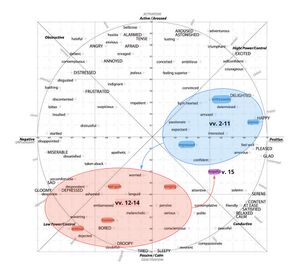User's Guide: Emotional
User's Guide Contents
Emotional Analysis
Introduction
The psalms are full of emotions. Consider the following three verses:
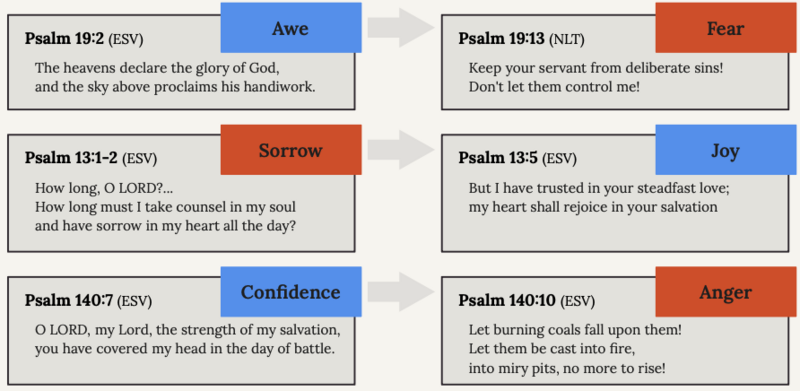
The psalms are also full of emotional journeys. Continue in each of these psalms and the emotions change completely ().
Our Emotional Analysis layer is designed to help you understand the emotions of the psalm. Here you can see how the emotions shift and develop, and how the emotional journey shapes the meaning of the psalm.
There are seven parts to our emotional analysis resources, split into three different places on the Resource Site: (1) The top of the Emotional Analysis page, (2) the bottom part of the Emotional Analysis page, (3) on a different page.
Top of Page
- At-a-Glance Overview: Main emotions in each section
- Emotional Overview: Emotions verse-by-verse + text
Bottom of Page
- Circumplex: Mapping the emotions
- Emotional Analysis Chart: Emotions verse-by-verse + analysis
- Think-Feel-Do: Understanding the emotions
Different Page
- Speech Act Chart: Notes on think-feel-do
- Dramatic Readings: Where the emotions come to life!
(Click above to toggle the At-a-Glance visual)
The quickest place to view the overview of the emotions in a psalm is in the At-a-Glance overview, which is presented fully on the Psalm Overview page, but can be also expanded and viewed at the top of the Emotional Analysis page.
This At-a-Glance visual is explained in detail on the Overview Page of the User’s Guide. The important point to highlight here is that for each section of the psalm the main emotion of that section is displayed in a pink box on the right. This allows you to see a high level view of the psalm as a whole, its main sections, and the overall emotions corresponding to those sections.
Emotional Overview
Beneath the At-a-Glance overview, we have the Emotional Overview/Emotions Tracking Text. Here, the emotions for every utterance of the psalm are displayed in a column to the right of the text. Each emotion is also colored red for negative emotions, or blue for positive. The shade shows how active or passive the emotion: dark blue and red for active, aroused, and intense, like triumphant or adventurous, angry or jealous, and light blue and red for passive, calm, and less intense, like peaceful and contemplative, depressed or exhausted. To see emotions mapped according to these categories, see the emotional circumplex to the right.
Note that many lines in the psalm can have multiple, even conflicting, emotions at the same time. See for example Psalm 88:2-3:
| Text (Hebrew) | Verse | Text (CBC) The Close-but-clear translation (CBC) exists to provide a window into the Hebrew text according to how we understand its syntax and word-to-phrase-level semantics. It is designed to be "close" to the Hebrew, while still being "clear." Specifically, the CBC encapsulates and reflects the following layers of analysis: grammar, lexical semantics, phrase-level semantics, and verbal semantics. It does not reflect our analysis of the discourse or of poetics. It is not intended to be used as a stand-alone translation or base text, but as a supplement to Layer-by-Layer materials to help users make full use of these resources. | Emotions (Positive) | Emotions (Negative) |
|---|---|---|---|---|
| יְ֭הוָה אֱלֹהֵ֣י יְשׁוּעָתִ֑י | 2a | YHWH, God of my salvation, | Hopeful |
Desperate
|
| יוֹם־צָעַ֖קְתִּי בַלַּ֣יְלָה נֶגְדֶּֽךָ׃ | 2b | I have been crying out day and night before you. | ||
| תָּב֣וֹא לְ֭פָנֶיךָ תְּפִלָּתִ֑י | 3a | May my prayer find favor with you! | ||
| הַטֵּֽה־אָ֝זְנְךָ֗ לְרִנָּתִֽי׃ | 3b | Incline your ear to my cry! |
Here the main emotion is clearly desperation, which fits with the rest of Ps 88 as a psalm full of pain, anger, humiliation, and distress. However, within the desperate cry out to God, undertones of hopefulness are also present, for example in addressing YHWH as “God of my salvation.”
Our full analysis and summary visuals are presented in the following tabs:
Circumplex
The emotional circumplex, also known as the affectiveAffective - relating to feelings, moods, and attitudes. circumplex, locates emotions on two axes: (1) positive vs. negative; and (2) active (aroused and intensive) vs. passive (calm and less intense). The circumplex therefore provides a way of mapping emotions according to these categories. Throughout our resources we color emotions according to these categories, as with the examples below:
| Negative | Positive | |
|---|---|---|
| Active/Aroused | Angry, jealous, disgusted | Triumphant, courageous, adventurous |
| Passive/Calm | Sad, depressed, exhausted | Peaceful, content, contemplative |
Once our analysis is complete, we highlight and circle the main emotions of the psalm on the circumplex, to show where on the circumplex the emotions of the psalm appear (see example to the right).
Emotional Analysis Chart
This chart contains detailed emotional analysis for every utterance of the psalm. We include a The Psalmist Feels column, where we identify the main emotions for every utterance, and an Emotional Analysis Notes column to add explanations and details where helpful.
| Verse | Text (Hebrew) | Text (CBC) The Close-but-clear translation (CBC) exists to provide a window into the Hebrew text according to how we understand its syntax and word-to-phrase-level semantics. It is designed to be "close" to the Hebrew, while still being "clear." Specifically, the CBC encapsulates and reflects the following layers of analysis: grammar, lexical semantics, phrase-level semantics, and verbal semantics. It does not reflect our analysis of the discourse or of poetics. It is not intended to be used as a stand-alone translation or base text, but as a supplement to Layer-by-Layer materials to help users make full use of these resources. | The Psalmist Feels | Emotional Analysis Notes |
|---|---|---|---|---|
| 88:5a | נֶ֭חְשַׁבְתִּי עִם־י֣וֹרְדֵי ב֑וֹר | I am counted with those who go down to the Pit. | • The psalmist is humiliated, because society marks him as impotent. • The psalmist is frustrated due to his incapability to act as a man and contribute to society. |
• The Pit is another term for the netherworld (Ezek 26:20, Prov 1:12, Ps 30:4, Isa 38:18). • The word גבר denotes "a man in his machismo... The grave is a place for people who have become totally incapable of doing anything" (Goldingay 2007).
|
| 88:5b | הָ֝יִ֗יתִי כְּגֶ֣בֶר אֵֽין־אֱיָֽל׃ | I have become just like a man who has no strength. |
This chart corresponds to the more detailed analysis of Intended Perlocution (Think-Feel-Do) in the Speech Act chart.
Think-Feel-Do
To fully analyze emotions, we must see emotions as more than just feelings by themselves. Feelings are woven together with thoughts and actions. Consider the example of someone seeing a large dog approach:
- (Thoughts) Think: “That dog looks dangerous; it might hurt me.”
- (Feelings) Feel: Fear, nervousness, a racing heart.
- (Actions) Do: Step back, run away, or avoid the dog.
Our Think-Feel-Do visual aims to present an overview of the thoughts, feeling, and actions in the psalm, and how they connect with each other. Here is an example from Ps 110:
Here we have identified four key thoughts that are important for understanding the emotions of the psalm:
- The king will sit on YHWH’s throne and rule with YHWH…
- YHWH will destroy the king’s enemies.
- YHWH has sworn that the king will be a priest forever.
- YHWH (and the king) will rule justly among the nations.
Alongside this THINK column, we have the FEEL column, with 5 main emotions: deference, awe, triumph, confidence, and hope. As you can see, the first thought about the king sitting on the throne is especially connected to the feelings of deference, awe, and confidence. Meanwhile, the final thought about YHWH (and the king) ruling justly leads to the feeling of hope. Moving over then to the DO column, we see four main actions that emerge in the psalm:
- Calls the king “my lord” and reports YHWH’s oracle
- Assures the king of his coming rule
- Assures the king of the certainty of YHWH’s promise
- Describes YHWH’s victory over enemies
Connecting lines then show which are the main feelings underlying these actions.
Emotional Resources on Other Pages
Speech Act Chart
- Important analysis corresponding to our THINK-FEEL-DO visual (#5 above) is laid out in detail in the intended perlocution section of the Speech Act chart, which you can read more about here.
Dramatic Readings
- To explore the emotions of a psalm, users may also want to listen to our dramatic readings, found on the listen and read page. Here we aim to bring the emotional journey to life, so you can hear for yourself all the sorrow, rage, and fear, all the awe, joy, and confidence.
- Take for example the following dramatic recordings from Ps 88:
| Dramatic Reading (Hebrew) |
Dramatic Reading (English) |
- The audio recordings take all of our layers into account, with special focus on emotional analysis, speech act analysis, prominence analysis, and macrosyntax.
